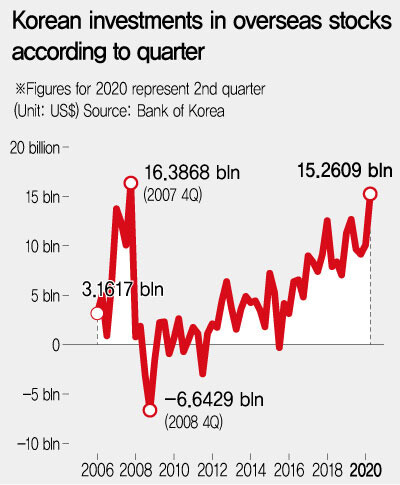hankyoreh
Links to other country sites 다른 나라 사이트 링크
Surge of investments of investments in overseas stocks prevents downward stabilization of won-dollar exchange rate

The failure of the won-to-dollar exchange rate to achieve downward stabilization despite the recent weakness of the US dollar is partly due to the effects of rising demand for the dollar amid a wave of foreign stock market investment by South Korean investors, an analysis shows.
According to figures released on Aug. 10 by the Korea Securities Depository (KSD), net purchasing of overseas stocks by South Korean investors totaled US$3.38081 billion from July 7 to Aug. 6, with 74.3% of that amount – around US$2.51 billion -- spent on US stocks. Tesla accounted for the most net purchasing of overseas stocks during that period at US$820.71 million, followed by US technology stocks such as Apple, Amazon, Nvidia, and Microsoft.
The scale of overseas stock investment by South Korean investors during the first half of 2020 was the third highest ever. According to Bank of Korea (BOK) figures on international balance financial accounts, South Korean investment in overseas stocks rose by US$25.35 billion during the first half of the year, reaching its highest level since the first and second halves of 2007 (respectively US$26.1 billion and US$26.46 billion). This was seen as reflecting an increase in demand on the exchange market with the selling of won and the purchasing of dollars, which has led to the won’s rise against the dollar. While the US dollar has declined in value by 3.6% against six other major currencies during the past month, the value of the won has bounced back by just 0.9%.
According to KB Securities, the ratio of overseas securities investment (including stocks and bonds) to GDP rose from 36.7% in 2010 all the way to 131% as of late 2019.
“Even when we consider the rise in valuation with the increase in stock values, the increased demand for dollars owing to growing overseas investment is offsetting the upward pressure on the won,” concluded Kim Hyo-jin, an economist with KB Securities.
An increase in domestic dollar-denominated deposits is also checking the won’s rise. According to a BOK report on trends in residents’ foreign currency-denominated deposits, South Koreans and South Korean businesses combined for a balance of US$84.53 billion in foreign-denominated deposits as of late June -- the highest level since statistics were first compiled in 2012. Dollar-denominated deposits accounted for US$3.54 billion of the US$3.61 billion increase over the past month, or 98%. Foreign-denominated deposits have been increasing for the past four months as businesses and investors scramble to acquire dollars amid the growing uncertainties associated with the COVID-19 pandemic.
On Aug. 10, the KOSPI index finished up by 34.71 (1.48%) at 2386.38, while the won-to-dollar exchange rate finished up 0.9 (indicating a decline in the won’s value) at 1,185.6. The exchange rate stood at 1,158 won to the dollar on Jan. 20, the date of South Korea’s first COVID-19 diagnosis. Experts predicted the rate is unlikely to achieve downward stabilization for the time being as the supply of dollars is reduced by a declining current account surplus combining with the increase in overseas investment.
“The exchange rate is unlikely to fall below 1,160 won to the dollar until there is a definite improvement in exports,” predicted Ha Geon-hyeong, an analysis with Shinhan Investment.
By Han Gwang-deok, finance correspondent
Please direct comments or questions to [english@hani.co.kr]

Editorial・opinion
![[Column] Season 2 of special prosecutor probe may be coming to Korea soon [Column] Season 2 of special prosecutor probe may be coming to Korea soon](https://flexible.img.hani.co.kr/flexible/normal/500/300/imgdb/original/2024/0426/3317141030699447.jpg) [Column] Season 2 of special prosecutor probe may be coming to Korea soon
[Column] Season 2 of special prosecutor probe may be coming to Korea soon![[Column] Park Geun-hye déjà vu in Yoon Suk-yeol [Column] Park Geun-hye déjà vu in Yoon Suk-yeol](https://flexible.img.hani.co.kr/flexible/normal/500/300/imgdb/original/2024/0424/651713945113788.jpg) [Column] Park Geun-hye déjà vu in Yoon Suk-yeol
[Column] Park Geun-hye déjà vu in Yoon Suk-yeol- [Editorial] New weight of N. Korea’s nuclear threats makes dialogue all the more urgent
- [Guest essay] The real reason Korea’s new right wants to dub Rhee a founding father
- [Column] ‘Choson’: Is it time we start referring to N. Korea in its own terms?
- [Editorial] Japan’s rewriting of history with Korea has gone too far
- [Column] The president’s questionable capacity for dialogue
- [Column] Are chaebol firms just pizza pies for families to divvy up as they please?
- [Column] Has Korea, too, crossed the Rubicon on China?
- [Correspondent’s column] In Japan’s alliance with US, echoes of its past alliances with UK
Most viewed articles
- 1‘We must say no’: Seoul defense chief on Korean, USFK involvement in hypothetical Taiwan crisis
- 2Why Kim Jong-un is scrapping the term ‘Day of the Sun’ and toning down fanfare for predecessors
- 3Two factors that’ll decide if Korea’s economy keeps on its upward trend
- 4After election rout, Yoon’s left with 3 choices for dealing with the opposition
- 5BTS says it wants to continue to “speak out against anti-Asian hate”
- 6AI is catching up with humans at a ‘shocking’ rate
- 7Noting shared ‘values,’ Korea hints at passport-free travel with Japan
- 8Gangnam murderer says he killed “because women have always ignored me”
- 9South Korea officially an aged society just 17 years after becoming aging society
- 10Ethnic Koreans in Japan's Utoro village wait for Seoul's help